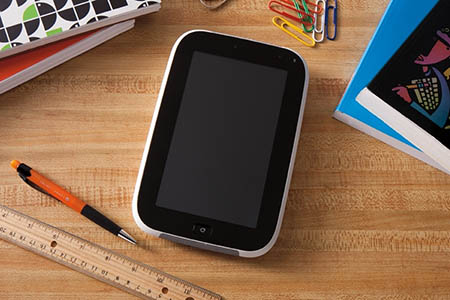The Intel Studybook: What an education tablet should be

When I first heard that Intel was planning a tablet iteration of its Learning Series Classmate PCs, I was incredibly skeptical. Intel had always maintained that a keyboard was important to ensure that students could be content creators as well as consumers. A tablet, then, would have to represent the ultimate market-driven, me-too sellout, right? Some hands-on time with their new Studybook tablet last week, however, convinced me that I was dead wrong.
The Studybook, announced today, is no iPad killer. It isn't meant to be. It is, however, the first purpose-built educational tablet that would be as valuable in the developing market as in mature markets and as at home in a high school student's backpack as on a 2nd-grader's desktop. Instead of fearfully watching primary school kids trucking around classrooms with iPads and their teachers wondering just what they should be doing with the $4-500 consumer devices, the Studybook comes loaded with a software stack and ecosystem for which even the least progressive of teachers could imagine a few uses.

And yes, I am raving about this little 7" tablet. And not just because the Intel folks bought me lunch during my hands-on time (although I must admit that the pot de crème I had for dessert was especially rich and creamy). And not because I've always liked Intel's approach to 1:1 with their Classmate PCs, which have always been characterized by solid software, professional development, and empowerment of local OEMs. Rather, it's because this tablet isn't a compromise for the sake of having tablets (because that's what students are supposed to be using the in the 21st Century Classroom, or so countless parents, administrator, and bureaucrats have told me). It can, in fact, do things that notebooks, netbooks, and other computing devices simply can't.
Powered by a low-voltage Atom Z650 (single-core with Hyperthreading and integrated graphics), the device is no more a speed demon than it is an iPad killer. However, the Android model I tested (running Honeycomb) is more than adequate for all-day use and never felt pokey. It's not the speed that will make educators take notice, though. It's the ruggedization and educational capacity that will raise eyebrows. Water resistant to tolerate use outside or in a lab with gaskets and seals around every port, the tablet is a portable science lab.
With a full-sized USB port, it can accept many of the probes and science tools on the market. LabCam software, with small adapter lenses, can convert the webcam into a portable microscope and front and rear cameras can be used to collect time-lapse data or be triggered by motion to take pictures of events that students might otherwise miss (emerging butterflies or hatching eggs, for example). Statistical data collection software can even show patterns in seemingly Brownian motion (e.g., the movement of ants across pheromone trails).
While the Learning Series Ecosystem partners are all porting apps to Android, the device also runs Windows, meaning that virtually any x86-compatible hardware and software can be used with the tablet. That's actually one of the more interesting benefits of the Atom processor. It may not be as fast or as efficient as many ARM-based chips, but schools can leverage existing purchases and software adoption with these tablets. This even includes the countless USB keyboards that schools invariably have sitting in closets, making the lack of an integrated keyboard a true non-issue when typing is necessary (and bigger hands struggle to touch type on the 7" screen).
Final pricing hasn't been announced, base models with 4GB of storage and WiFi only are expected to debut in the sub-$200 range. Option like Gorilla Glass, 3G, upgraded storage, Windows 7, etc., will certainly drive the price up. However, a very well-equipped tablet shouldn't push much above $300. Since each tablet includes software that allows it to double as a scientific interfaces, the Studybooks will enable schools to provide observational and investigative tools for many more students. Similarly, Kno is providing e-reading software and expanding K12 content for the tablets, paving the way for ebook cost savings if anyone can figure out reasonable educational licensing.
Finally, the tablets are fully manageable using Intel tools, including those outlined in their new Teacher PC spec (a reference design and software stack for machines that teachers can use to develop content and administer the devices).
In this price range, for a highly ruggedized tablet with a great educational software/hardware/content ecosystem, the Studybook represents a huge leap forward, a great value, and finally a smart and reasonable alternative to the ubiquitous iPad. I'm sure we'll see incremental improvements in speed and battery life and Windows 8 may be interesting on these little tablets, but as it stands right now, it's hard to argue with the new Studybook as the 1:1 device of choice for schools that don't have specifically defined needs for notebooks or desktops.